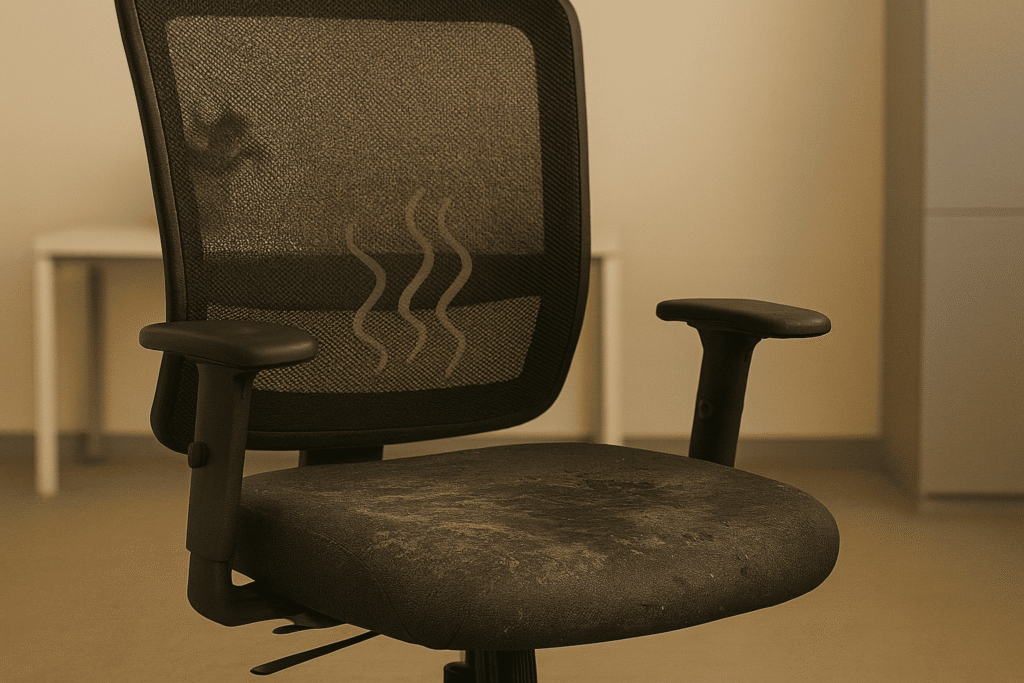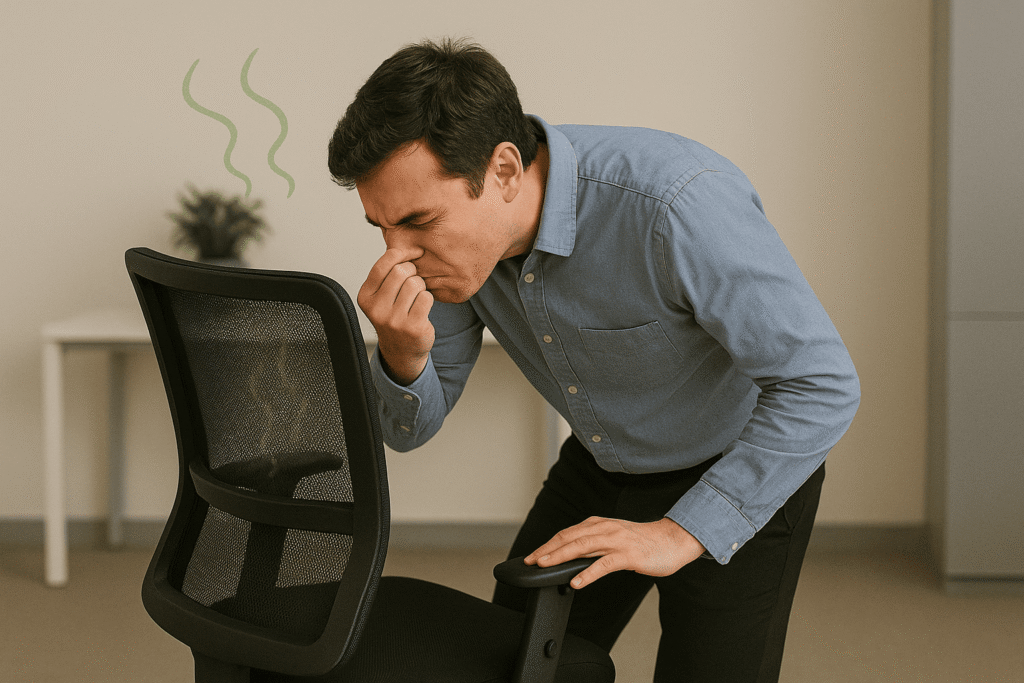Table of Contents
ToggleIntroduction
People are using office chairs a lot more now that they can work from home and spend long hours at their desks. Over time, these seats can hold smells from sweat, spilled coffee, food crumbs, or even pet hair. If you don’t clean it, a seat that was previously clean can come to smell musty or sour. It’s crucial to clean a chair carefully so that you can get rid of the smell without hurting delicate textiles like mesh, faux leather, or special upholstery. We’ll show you cheap, eco-friendly ways to clean your chair in this tutorial. We’ll also teach you how to avoid using harsh treatments that could damage the material. What happened? This results in a chair that lasts longer and a workspace that is healthier and more enjoyable.
Why Office Chairs Smell Over Time

There are a few reasons why office chairs can start to smell bad:
- Body oils and sweat: When you sit for a long time, your skin oils and sweat soak into the foam or fabric. This makes a place where germs that cause bad smells can grow. Microbes can eat body waste and generate a sour scent, even if you can’t see it.
- Stains and spills: Coffee, soda, or food crumbs can get into porous materials. Craddock’s Cleaning says that “even small amounts of liquid can get through the chair’s material, especially if it is porous.” These residues can ferment or develop mildew over time, resulting in persistent odors.
- Dirt and dust that gets stuck in seams or under cushions can mix with moisture and smell. Cleaning your chair regularly keeps scents away; on the other hand, “not cleaning your chair lets odors build up.”
- Mold and mildew: When there is a lot of moisture in the air or not enough airflow, it can cause mold to grow. Mold is often present when there are musty “mildew smells.” One cleaning firm says that chairs kept in moist places may become “a lost cause no matter how much cleaning you do“.
Any of these things, especially when they happen together, can make a chair smell bad. The good news is that most smells are on the surface or come from living things, so natural cleaners can get rid of them. The most important thing is to clean and deodorize without hurting the chair’s materials.
Materials Matter – Understanding Your Office Chair’s Fabric
Different chair materials require different care. Here’s a quick overview of common upholstery types, their odor tendencies, moisture sensitivity, and cleaning ease:
Material | Odor Retention | Moisture Sensitivity | Cleaning Notes | Mesh (polyester) | Low – highly breathable | Low – dries quickly | Easy to clean: vacuum regularly and blot stains. Avoid scrubbing to prevent fraying. Mesh breathes well, so odors don’t linger as much. |
|---|---|---|---|
Fabric (cloth) | Highly absorbent | High – holds liquids | Odors soak in easily. Check the care tag (W/S/X code) before using water or solvent cleaners. Typically you can spot-clean with mild soap and warm water, then air dry. |
Leather/Faux Leather | Medium – can absorb some sweat but surface-wipeable | Low – non-porous surface | Use a manufacturer-recommended leather cleaner or a gentle soap solution. Wipe spills immediately; do not use bleach/ammonia (they discolor leather). |
Vinyl/Plastic | Low- essentially waterproof | Very Low – repels moisture | Clean easily with mild soap and water. (Note: bleach or harsh solvents can crack or dull vinyl, so they’re best avoided.) |
Each material handles moisture differently. Mesh allows airflow, so it resists odor but can sag if abused. Fabric traps spills, so prompt cleaning is a must. Leather looks and feels high-end and can be wiped down easily, but it can dry out or stain with the wrong cleaners. Vinyl and plastic are the hardiest – water just beads off them – but some cheap plastics can fade or become brittle if harsh chemicals are used. Always check the tag under your chair: many office chairs have a fabric code (W, S, WS, or X) indicating the safe cleaning method. When in doubt, vacuuming and spot-testing a mild cleaner are safe bets.
Comparison Chart of Office Chair Materials
Material | Odor Retention | Moisture Sensitivity | Cleaning Ease |
|---|---|---|---|
Mesh (polyester) | Low (breathable) | Low (quick-dry) | High – Vacuum and dab stains |
Fabric (cloth) | High (absorbent) | High (liquid-absorbing) | Medium – Use mild soap or dry cleaners (see tag) |
Leather/Faux | Medium | Low (surface only) | Medium – Wipe with gentle cleaner; avoid bleach |
Vinyl/Plastic | Low | Very Low | High – Soap and water works; avoid bleach |
This chart shows how sensitive each material is to general cleaning. For instance, NBF’s cleaning guide says that vinyl can handle diluted bleach in some instances (although we don’t recommend it). Chairs made of mesh and plastic are usually the simplest to keep clean. When using water or solvent cleaners on more absorbent fabrics, you need to be careful.
How to Deodorize and Refresh Your Office Chair the Right Way
Expert Tips from Oscar, Refurbishing Specialist at Nulife Chairs
As someone who has refurbished countless Herman Miller Aeron chairs, I’ve seen every kind of buildup, odor, and wear. With the right approach, you can restore freshness without damaging the materials. Here’s how I do it.
Pre-Cleaning Steps (Before You Deodorize)
Before applying any deodorizer, prepare your chair properly.
1. Vacuum Thoroughly
Use your vacuum’s upholstery attachment to remove dust, hair, and crumbs from all surfaces, seams, and under cushions. Regular vacuuming prevents dirt from spreading and helps keep the chair looking and smelling clean.
2. Check Cleaning Codes
Look under the seat for a care tag marked W (water-safe), S (solvent-only), WS (both), or X (vacuum-only). These codes tell you what’s safe for the fabric. When unsure, test the cleaner on a hidden spot first to ensure no color fading or damage.
3. Spot-Test Cleaners
Always test new solutions in an inconspicuous area before full use. Let it sit for a few minutes and wipe dry to confirm it doesn’t affect the color or texture.
4. Remove Cushions and Covers
If removable, wash covers or cushions separately. Sunlight can also help disinfect and eliminate odors. Make sure all parts are completely dry before reassembling.
Taking your time here prevents dirt from setting deeper into the fabric when you start cleaning.
Eco-Friendly and Budget-Friendly Deodorizing Methods
Once prepped, try these simple, safe, and effective methods.
Vinegar and Baking Soda
Mix equal parts white vinegar and water (or 1:2 for mild odors). Lightly spray on the fabric or mesh. Vinegar contains acetic acid, which “breaks down bacteria and other compounds that cause odors.” Let it air dry completely.
Then sprinkle baking soda over smelly areas. It “chemically reacts with odor-causing compounds, breaking them down and getting rid of the smell.” Let it sit for 15–30 minutes, then vacuum thoroughly.
(Optional: add lavender or tea tree essential oil for a natural scent.)
This method works for most fabrics and mesh without using harsh chemicals.
Activated Charcoal Bags
Place bamboo charcoal bags under or near your chair. The charcoal’s porous surface “adsorbs moisture and smell molecules from the air.“
They work gradually but continuously. Reactivate them monthly by airing out in the sun. Ideal for maintaining freshness in small spaces.
Enzyme-Based Cleaners
For stronger odors caused by sweat, spills, or food, enzyme cleaners are effective. These contain bacteria or enzymes that break down organic matter; the source of most odors.
According to Neutron Industries, enzyme cleaners “break down organic matter such as food or other organic wastes that cause stains and odors.” Spray, let sit for 10–15 minutes, then wipe dry. Always test first to ensure fabric safety.
After cleaning, allow the chair to air out completely before using it again.
What Not to Use (Avoid Damaging Materials)
Avoid harsh products and tools that can ruin the finish or weaken materials.
Bleach and Ammonia
Both can fade or yellow fabric and leather, and ammonia can cause cracking. A leather care guide warns, “Don’t use products that have bleach or ammonia in them because they can change the color of your chair or even damage it over time.“
Strong Alcohol Sprays
Undiluted alcohol can strip finishes and colors. Only use diluted solutions on leather, never on mesh or fabric.
Harsh Scrubbing Pads or Brushes
These can fray mesh and scratch leather or vinyl. Always use soft towels or brushes.
Steam Cleaners
Heat and moisture can warp plastic or rust metal parts. Some steam cleaners “kill bacteria,” but “always check the manufacturer’s instructions to see if it’s safe.” If uncertain, stick to air drying or gentle wipes.
This is the same process we use at Nulife Chairs when refurbishing Herman Miller Aeron chairs. With these methods, you can keep your chair fresh, clean, and in great shape for years.
How to Keep the Chair Smelling Fresh Long-Term
It’s easier to prevent smells than remove them. Follow these steps to keep your chair fresh:
Weekly vacuuming: Vacuum once a week, even if it looks clean. This removes skin flakes, dust, and other debris before odors form. Sailrite says regular vacuuming helps the fabric last longer. Check cracks and under cushions too.
Use breathable chair covers: Slipcovers made of cotton, bamboo, or light polyester protect upholstery from spills and sweat. Choose covers labeled “breathable” or “moisture-wicking.” They’re easy to remove and wash, keeping the chair clean without harming the material.
Light cleaning: Spray a fabric-safe deodorizer or a DIY mix of 50% water with a few drops of lavender oil between deep cleans. You can also sprinkle baking soda monthly, leave for 15 minutes, then vacuum it off to deodorize naturally.
Airflow: Keep your workspace ventilated. If the chair gets wet, use a fan or open window to dry it faster. CleanMethod notes that letting a chair sit outside briefly can remove “new office” or old lingering smells.
After working out: Avoid sitting down while sweaty. Place a towel on the chair until you cool off and dry to prevent sweat and oils from seeping into the fabric.
Natural purifiers: Use an odor absorber like a small bamboo charcoal bag near your chair. Air-purifying plants such as bamboo palm, peace lily, or English ivy can also improve air quality and reduce odors.
Consistent cleaning and care prevent most odors from forming.
When to Consider Professional Cleaning or Replacement
Sometimes DIY cleaning isn’t enough. You may need professional help or a replacement if:
- Persistent odors: If you’ve vacuumed and used vinegar, baking soda, or enzyme cleaners several times and smells remain, it may be trapped in the padding or frame. Chairs exposed to moisture or mildew can develop musty odors that are hard to remove (source).
- Mold or mildew: Black spots, musty smells, or odd stains indicate mold. Mold inside cushions or foam is unsafe and usually means replacement is best.
- Worn upholstery: Tears, thin fabric, or deformed foam trap dirt and odors. Replacement is often more practical than repair.
- Chair age and quality: Office furniture experts say good chairs last 5–10 years . If yours is older and smells bad, consider repair or replacement.
Cost comparison:
Professional deep cleaning costs about $120–$230 per chair, averaging $174. A quality ergonomic chair ranges from $250 to $850, while basic task chairs can be under $200.
If the chair is still sturdy and not too old, professional cleaning can extend its life at a lower cost. FlexiSpot notes that chairs with an “X” cleaning code require specialist care to prevent damage.
If the chair is old, inexpensive, or structurally damaged, buying new is often better. A new chair has fresh foam and springs, removing any lingering smells. Consumer experts recommend replacing chairs with broken levers or worn-out foam. Even top-quality models last about 12–15 years.
In short: Try home remedies first. If odors persist, compare cleaning versus replacement costs. Cleaning works for moderate cases, while replacement is best for old or heavily damaged chairs.
Conclusion
You don’t need expensive gear or strong chemicals to keep your office chair smelling clean. You may get rid of smells on any chair fabric by taking care of it regularly and using natural products like vinegar, baking soda, or enzymes. Always clean up by vacuuming and verifying the cleaning codes. Do not use bleach, strong alcohol, or scrubbing brushes that could damage the materials. A little bit of upkeep, such as vacuuming once a week and allowing the chair to breathe, goes a long way. Following these tips will help your chair last longer, keep your workstation cleaner, and save you money (as well as trips to the shop) in the long term. New seats mean a new mind!
Frequently Asked Questions (FAQs)
What is the best natural deodorizer for office furniture?
Baking soda is the best natural deodorizer, sprinkle it on the chair, wait 15–30 minutes, then vacuum. It removes odors without chemicals. White vinegar spray also kills bacteria and removes scents; air out the chair afterward to freshen it. Bamboo charcoal bags absorb smells slowly over time. Essential oils like tea tree or eucalyptus can mask odors but only use them after the smell is gone, and ensure they don’t stain fabric.
What’s the safest way to clean faux leather office chairs?
Vinyl looks like leather and is strong but still needs care. Use a soft cloth with warm water and mild soap, such as gentle hand soap. Wipe and let it dry fully. For tougher dirt, mix water with white vinegar or use a vinyl cleaner. Don’t use bleach, alcohol, or rough pads, they can damage or discolor the surface. After cleaning, you can apply baby oil or furniture conditioner, but test on a hidden spot first. The safest method is warm water and mild soap.
How do I get a musty smell out of my office chair?
Check for mold or dampness first. If the chair is moist, let it dry completely in the sun or air. Then spray a mix of white vinegar and water to kill mold and bacteria, and let it dry. Once dry, sprinkle baking soda, let it sit, and vacuum it up. Repeat if needed. For strong musty odors, use an enzymatic cleaner or hire a professional. Keep humidity low and vacuum often to prevent new mold growth.
Can sweat cause long-term damage or odor in mesh chairs?
Sweat doesn’t damage mesh fabric but can cause lingering odors if not cleaned. Mesh allows airflow, so sweat dries faster than on foam, but salt and oils can build up, causing discoloration and smell. Regular wiping or light cleaning after heavy use prevents this. Bacteria feed on old sweat, creating odor. In short, sweat won’t harm mesh, but it will smell if left uncleaned; wipe with a damp cloth or mild cleaner and let it dry.
Are enzyme cleaners safe for office chair cushions?
Yes, but only if you choose the right one. Look for an “enzyme upholstery cleaner” or a pet stain remover safe for fabrics. These are gentle yet effective on organic stains like sweat, food, or urine. Enzymes, not harsh chemicals, do the cleaning. Most are eco-friendly, color-safe, and non-toxic. Always test a small spot first. If the cushion cover is removable, you can wash it with enzyme laundry detergent. The cushion may need extra drying time, but enzyme cleaners usually won’t harm foam or fabric.
Looking for more sustainable office solutions?
Explore our range of eco-friendly, budget-conscious ergonomic chairs that stay fresher longer.


